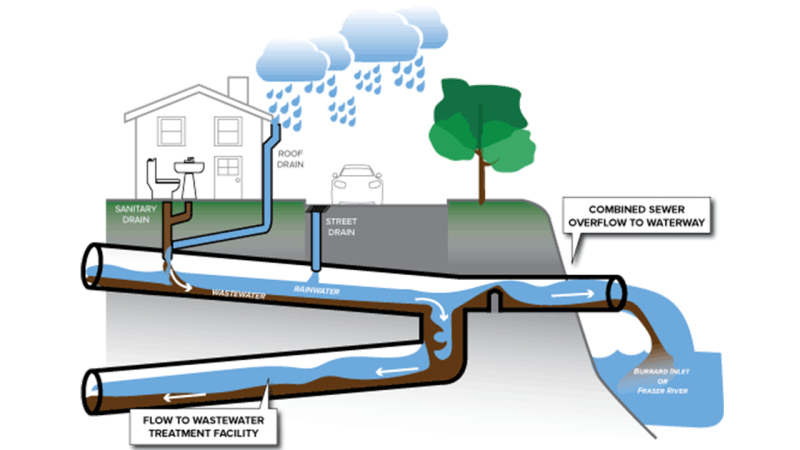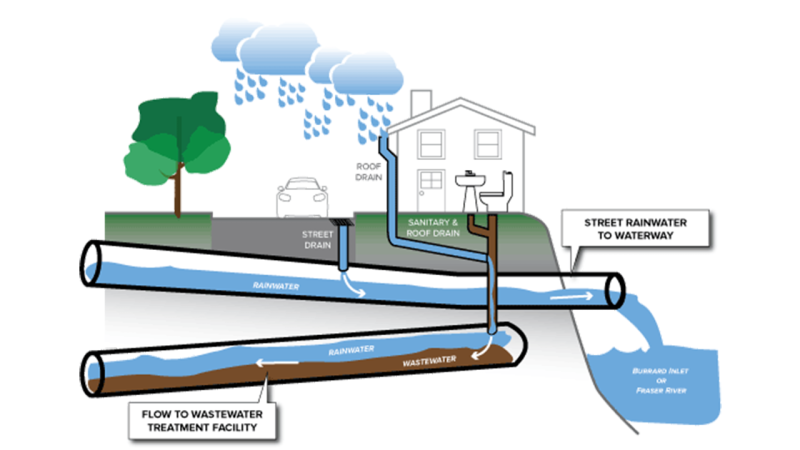Burnaby's storm sewer system collects stormwater runoff from impermeable surfaces–buildings, roads, parking lots–and discharges it into the waters surrounding Burnaby, including Burrard Inlet and the Fraser River.
Burnaby's sanitary sewer system collects sewage from homes and businesses and sends it through a network of pipes and pump stations to Metro Vancouver's trunk network and treatment plants.
For more than 30 years, Burnaby has been upgrading its older sewer systems–from combined to separate–to isolate rainwater from wastewater. Only 7% of the City's sewers now require separation, namely the Burnaby Heights and Glenbrook neighbourhoods.
Storm sewers
Over 460 km of storm sewers and a similar number of ditches drain into our creeks and streams and end up in 1 of 3 major rivers. Stormwater from north Burnaby ends up in Burrard Inlet, while central valley stormwater drains into Still Creek and Brunette River, and eventually into the Fraser River. South Burnaby's creeks and streams end up in the north arm of the Fraser River.
We maintain pipes and ditches to ensure water flows uninterrupted to these outlets thereby reducing the risk of flooding to homes and businesses. We work closely with local environmental stewardship groups and fishery agencies to ensure our activities are environmentally responsible. We also work with the Climate Action and Energy division to track spills and minimize the damage that a spill may cause.
Sanitary sewers
Our sewer staff operate and maintain 690 km of sanitary and combined sewer mains, 23 pump stations and over 36,000 service connections.
Maintenance activities involve cleaning sewers using flush trucks, inspecting and repairing utility holes, repairing broken sewer mains and services, and inflow and infiltration management.
Combined sewer separation program
Combined sewer systems collect sanitary sewage and stormwater in a single sewer system. These sewer systems can't carry all the sewage flows to regional treatment plants during wet weather and discharge the excess into Burrard Inlet and the Fraser River.
Overflows negatively impact the environment. Therefore, Burnaby plans to eliminate all existing combined sewers and build new separated sewage systems.
So far, Burnaby has invested nearly $40 million and successfully separated nearly half of its original 85 km of combined sewer inventory. The City's commitment to combined sewer separation is outlined in the Integrated Liquid Waste and Resource Management Plan (ILWRMP).
Combined sewer overflow volumes
Spill volumes are electronically monitored and recorded on an ongoing basis. Once a year, the flow data is reviewed, vetted and submitted to governments per the ILWRMP and the federal wastewater systems effluent regulations.
You can view the status of the 2 City-owned combined sewer outfalls (Gilmore and Westridge), including current, monthly and year-to-date estimated CSO spill volumes on this CSO notification map. You can also view the local rainfall data records.
Why separate sewers?
We separate sewers to ensure a cleaner environment.
Combined single-pipe systems mix rainwater with wastewater (from residential and industrial properties). During extreme weather, these combined systems can get overloaded and sometimes allow untreated sewage to overflow into Burrard Inlet (from Burnaby Heights) or the Fraser River (from Glenbrook).
Installing a twinned pipe system will eliminate overflows of untreated wastewater, providing immediate environmental benefits to the waters of Burrard Inlet or the Fraser River.
Fully upgraded sewer system
Upgraded by the homeowner and the City:
Legacy sewer system
Combined sewer from home to combined sewer in the street:
Partially upgraded sewer system
Separated sewer in the street with original combined sewer on the homeowner's property. Since wastewater is not separated at home, the environmental benefits of separated pipes are not fully realized.
Apply for a grant to separate sewer lines on your property
Until all homes have 2 separate lines, the wastewater from homes mixed with rainwater will continue to reach the treatment plant and overflow into Burrard Inlet or the Fraser River.
The City currently offers eligible homeowners a grant of up to $2,500 to offset the cost of upgrading your combined sewer connection that runs from your home to the new city lines.


